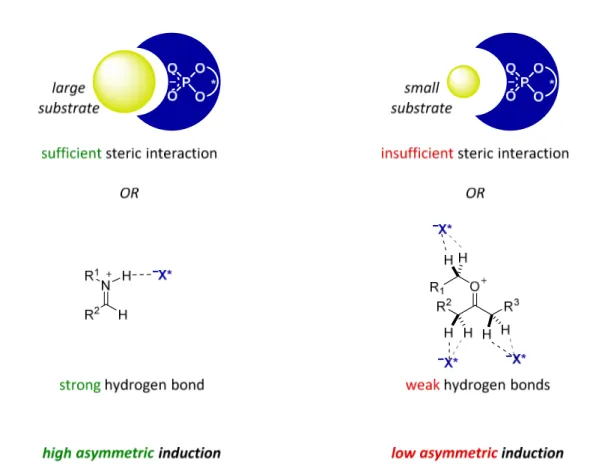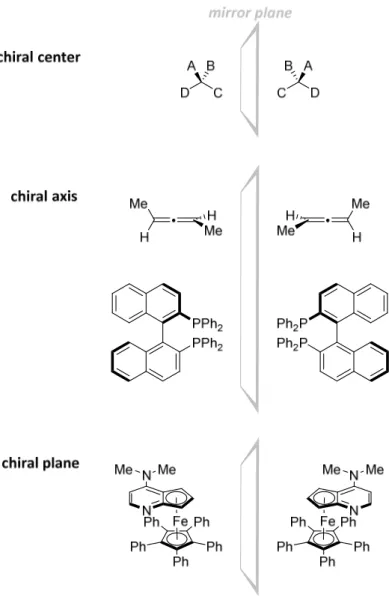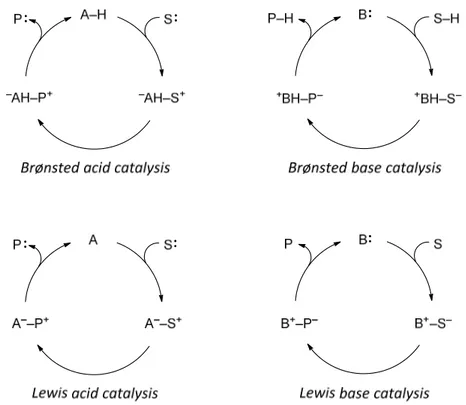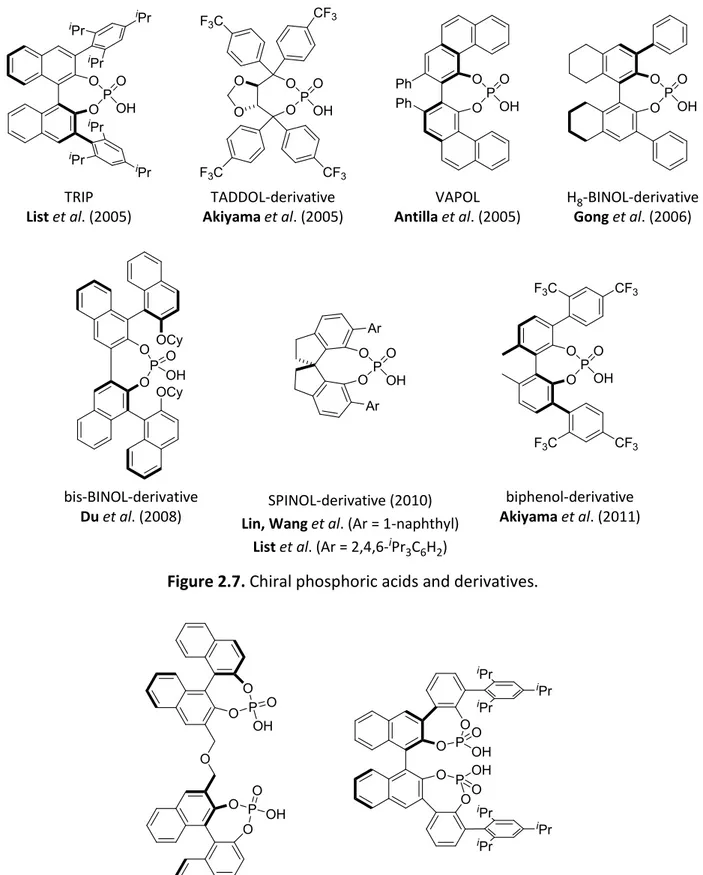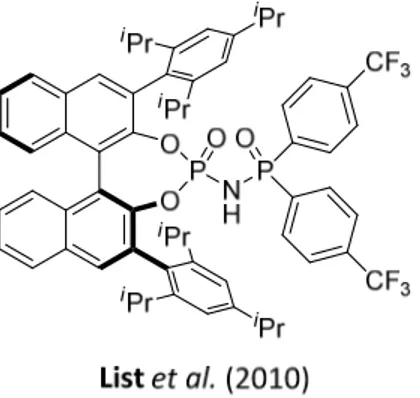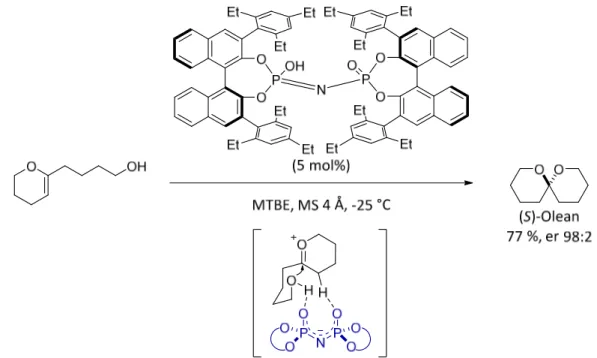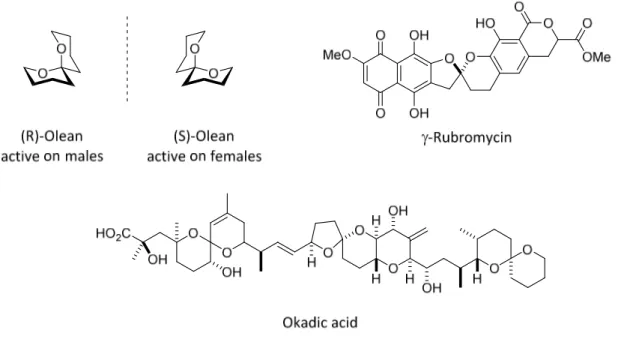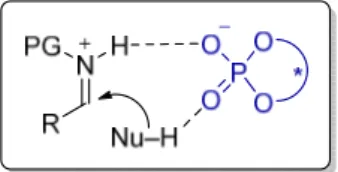B RØNSTED A CID C ATALYZED A SYMMETRIC A CETALIZATIONS
I n a u g u r a l - D i s s e r t a t i o n
zur
Erlangung des Doktorgrades
der Mathematisch-Naturwissenschaftlichen Fakultät der Universität zu Köln
vorgelegt von Ji Hye Kim aus Jinhae (Süd Korea)
Köln 2015
Berichterstatter: Prof. Dr. Benjamin List Prof. Dr. Albrecht Berkessel
TABLE OF CONTENTS
ABSTRACT ... III KURZZUSAMMENFASSUNG ... IV LIST OF SIMBOLS AND ABBREVIATIONS ... V ACKNOWLEDGEMENTS ... VIII
1. INTRODUCTION ... 1
1.1. Catalytic asymmetric synthesis of acetals... 1
1.2. Kinetic resolution of diols via acetal formation ... 2
1.3. Brønsted acid catalysis with challenging substrates ... 4
2. BACKGROUND ... 6
2.1. Asymmetric catalysis ... 6
2.2. Asymmetric organocatalysis ... 9
2.3. Asymmetric Brønsted acid catalysis ... 12
2.3.1. General Brønsted acid catalysis ... 13
2.3.2. Specific Brønsted acid catalysis ... 15
2.3.3. Confined Brønsted acids... 20
2.4. Chiral acetals ... 28
2.4.1. Organocatalytic asymmetric acetalizations via iminium intermediates. ... 31
2.4.2. Approaches to the synthesis of enantioenriched O,O-acetals ... 35
2.5. Asymmetric synthesis of diols ... 45
2.5.1. Synthetic approaches to enantioenriched diols... 45
2.5.2. Kinetic resolution of alcohols ... 49
3. OBJECTIVES OF THIS PH.D. WORK ... 53
3.1. Catalytic asymmetric acetalization of aldehydes with diols ... 53
3.2. Kinetic resolution of diols via acetal formation ... 55
4. RESULTS AND DISCUSSION ... 57
4.1. Catalytic asymmetric acetalization ... 57
4.1.1. Reaction design and optimization ... 57
4.1.2. Substrate scope ... 62
4.1.3. Discussion ... 67
4.2. Resolutions of diols via catalytic asymmetric acetalization ... 73
4.2.1. Reaction design and optimization ... 73
4.2.2. Substrate scope ... 79
4.2.3. Stereodivergent access to enantioenriched diols ... 87
4.2.4. Discussion ... 89
5. SUMMARY ... 92
5.1. Catalytic asymmetric acetalization ... 92
5.2. Kinetic resolution of diols via catalytic asymmetric acetalization ... 93
6. OUTLOOK ... 95
6.1. Acetals for fragrance chemistry ... 95
6.2. Brønsted acid catalyzed asymmetric S,O-acetalization ... 96
6.3. Brønsted acid catalyzed asymmetric S,S-acetalization ... 98
7. EXPERIMENTAL SECTION ... 99
7.1. General experimental conditions ... 99
7.2. Catalytic asymmetric acetalization ... 102
7.2.1. Starting materials ... 102
7.2.2. Products ... 106
7.2.3. X-Ray data for compounds 4j and 4x ... 118
7.2.4. Mechanistic studies ... 124
7.2.5. Synthesis of confined Brønsted acid ... 127
7.3. Resolutions of diols via asymmetric acetalization ... 138
7.3.1. Synthesis of starting materials ... 138
7.3.2. Kinetic resolution of diols ... 144
7.3.3. Determination of conversion and selectivity factors ... 166
7.3.4. Synthesis of catalyst 5k ... 168
7.3.5. Stereodivergent resolution of diols ... 174
8. BIBLIOGRAPHY ... 178
9. APPENDIX ... 185
9.1. Erklärung ... 185
This work describes the development of Brønsted acid catalyzed asymmetric acetalization of aldehydes and its application to kinetic resolution of chiral diols.
In the first part, the first asymmetric version of the direct O,O-acetalization of aldehydes with 1,2- and 1,3-diols is presented. The reaction is catalyzed by chiral confined Brønsted acids, which are based on an imidodiphosphoric acid moiety and can provide structurally versatile confined chiral microenvironments. A new confined catalyst significantly outperformed previously established phosphoric acids and their derivatives, giving highly enantioenriched acetal products. The catalyst is readily prepared from the natural product thymol, possessing isopropyl and methyl substituents in the 2- and 5-position, respectively, on the aryl group providing a more rigid catalyst structure. A highly enantioselective reaction can be performed delivering acetals with excellent enantioselectivity (er up to 99.8:0.2) and excellent yields. The method tolerates both aliphatic and aromatic aldehydes delivering the corresponding acetal products with high enantioselectivities.
The second part of this thesis describes a highly enantioselective kinetic resolution of chiral racemic diols through acetal formation employing the thymol derived imidodiphosphoric acid catalyst and an even bulkier catalyst which possesses a cyclohexyl substituent instead of the isopropyl substituent in the 2-position on the aryl group. The reaction is highly efficient for the resolution of diols with tertiary alcohol stereocenters, giving selectivity factors of up to 389. Remarkably, in cases where the selectivity factors are only moderate, highly enantioenriched diols can still be obtained via a stereodivergent resolution to diastereomeric acetals. This approach can be used for resolution of 1,2-diols possessing similar aliphatic substituents at the tertiary alcohol stereocenter.
Initial studies regarding the development of related asymmetric S,O- and S,S- acetalizations are also presented in this thesis.
KURZZUSAMMENFASSUNG
Diese Arbeit beschreibt die Entwicklung einer Brønstedsäure-katalysierten asymmetrischen Acetalisierung von Aldehyden und deren Anwendung in der kinetischen Racematspaltung von chiralen Diolen.
Im ersten Teil dieser Arbeit wird die erste asymmetrische direkte O,O-Acetalisierung von Aldehyden mit 1,2- und 1,3-Diolen vorgestellt. Die Reaktion wird durch chirale sterisch anspruchsvolle Brønstedsäuren katalysiert, die eine Imidodiphosphorsäure-Einheit enthalten und eine Vielzahl chiraler Mikroumgebungen ermöglichen.
Ein neuer sterisch anspruchsvoller Katalysator lieferte deutlich bessere Ergebnisse als bisher etablierte Phosphorsäuren und deren Derivate und ermöglichte die Synthese hoch enantiomerenreiner Acetale als Produkte. Der Katalysator ist leicht zugänglich und kann ausgehend vom Naturstoff Thymol synthetisiert werden, welcher einen Isopropyl- und Methyl- Substituenten in der 2- und 5-Position besitzt und so eine starre Katalysatorstruktur aufweist.
Dies ermöglicht die Synthese von Acetalen mit exzellenter Enantioselektivität (er bis zu 99.8:0.2) und hoher Ausbeute. Die Methode toleriert sowohl aliphatische als auch aromatische Aldehyde und liefert die entsprechenden Acetale in hohen Enantioselektivitäten.
Der zweite Teil dieser Arbeit beschreibt eine hochselektive kinetische Racematspaltung von racemischen Diolen durch Acetalbildung. Hierfür wurde eine sterisch anspruchsvollere Imidodiphosphorsäure mit Cyclohexyl- und Methyl-Substituenten in der 2-und 5-Position der Aryl-Gruppe verwendet. Die Reaktion ist sehr effizient für die Auftrennung von Diolen mit tertiären Alkohol-Stereozentren und liefert Selektivitätsfaktoren von bis zu 389. In Fällen, in denen der Selektivitätsfaktor geringer ist, können trotzdem enantiomerenreine Diole durch eine stereodivergente Racematspaltung zu diastereomeren Acetalen erhalten werden. Diese Methode kann zur Racematspaltung von 1,2-Diolen mit ähnlichen Substituenten am tertiären Stereozentrum angewandt werden.
Erste Untersuchungen zur Entwicklung von asymmetrischen S,O- und S,S- Acetalisierungen werden ebenfalls in dieser Arbeit vorgestellt.
LIST OF SIMBOLS AND ABBREVIATIONS
* designating chiral moiety
Ac acetyl
acac acetylacetonate
AIBN azobis(isobutyronitrile)
Alk alkyl
Ar aryl, aromatic
aq. aqueous
Boc tert-butyloxycarbonyl BINOL 1,1'-bi-2-naphthol
Bn benzyl
Bu butyl
Bz benzoyl
cat. catalyst/catalytic
conv. conversion
d doublet
dba (E,E)-dibenzylideneacetone
DCE 1,2-dichloroethane
DCM dichloromethane
(DHQ)2-PHAL 1,4-bis(dihydroquininyl)phthalazine (DHQD)2-PHAL 1,4-bis(dihydroquinidinyl)phthalazine
DIOP 2,3-O-isopropylidene-2,3-dihydroxy-1,4-bis(diphenylphosphino)butane DIPEA diisopropylethylamine
DMAP 4-dimethylaminopyridine
DMF dimethylformamide
DMSO dimethylsulfoxide
dr diastereomeric ratio
EI electron impact
ent enantiomer(ic)
equiv equivalent(s)
er enantiomeric ratio
Et ethyl
ESI electrospray ionization
GC (GC-MS) gas chromatography (gas chromatography coupled with mass detection) H8-BINOL 5,5’,6,6’,7,7’,8,8’-octahydro-1,1’-bi-2-naphtol
HOMO highest occupied molecular orbital HPLC high performance liquid chromatography HRMS high resolution mass spectrometry
HX* designating chiral Brønsted acids, e.g. chiral phosphoric acid diesters L ligand (abbreviation used in schemes)
LUMO lowest unoccupied molecular orbital
m meta
m multiplet
M metal (abbreviation used in schemes)
M molar (concentration)
Me methyl
MS mass spectrometry, molecular sieves MTBE methyl tert-butyl ether
MW molecular weight
m/z atomic mass units per charge
N normal (concentration)
nbd norbornadiene
NMR nuclear magnetic resonance spectroscopy NOE(SY) nuclear Overhauser effect (spectroscopy)
NuH/Nu nucleophile
o ortho
p para
PG protecting group
Ph phenyl
PMP para-methoxyphenyl
quint quintet
rac. racemic
r.t. room temperature
sept septet
sext sextet
SPINOL 1,1’-spirobiindane-7,7’-diol
t tert, tertiary
t triplet
TADDOL α,α,α’,α’-tetraaryl-1,3-dioxolan-4,5-dimethanol TBS tert-butyl-dimethylsilyl
TES -SiEt3
Tf -SO2CF3
TFA trifluoroacetic acid TFAA trifluoroacetic anhydride
THF tetrahydrofuran
THP tetrahydropyran
TLC thin layer chromatography
TMS trimethylsilyl
TRIP 3,3'-bis(2,4,6-triisopropylphenyl)-1,1'-binaphthyl-2,2'-diyl hydrogen phosphate
VAPOL 2,2′-Diphenyl-(4-biphenanthrol)
ACKNOWLEDGEMENTS
I am extremely grateful to Prof. Dr. Benjamin List for giving me the opportunity to work in the wonderful research environment of the Max-Planck Institut für Kohlenforschung. I am indebted to him for his academic support, for the encouragement to tackle challenging problems, and for being always motivating and inspiring. I feel honored to be one of his graduate students and to have been exposed to a great scientific atmosphere in the List group.
I am grateful to Prof. Dr. Albrecht Berkessel for accepting to review this thesis and to Prof. Dr. Axel Klein and Dr. Martin Klußman for serving on my defense committee. I also thank Mattia Monaco, Gabriele Pupo, Dr. Thomas James, Dr. Manuel van Gemmeren and Dr. Ilija Čorić for kindly proofreading this thesis and for their valuable suggestions.
I would like to thank professors Eun Joo Kang and Kwang-Hyun Ahn for being highly inspiring during my master studies. I also thank Prof. Dr. Mikiko Sodeoka for enabling me to have valuable research time at RIKEN in Japan.
I am extremely grateful to Dr. Ilija Čorić who developed the imidodiphosphoric acids and worked with me on the acetalization and the kinetic resolution projects. I would also like to thank Dr. Chiara Palumbo for collaborating with me on the kinetic resolution project and Natascha Wippich for providing me with valuable catalysts. I am grateful to Dr. Philip Kraft from the Fragrance Research department of Givaudan Schweiz AG for the odor evaluation of my acetal compound.
I would like to thank Alexandra Kaltsidis and Dr. Monika Lindner for their support in various forms, and all of the technician staff, especially Marianne Hannappel, Simone Marcus, Hendrik van Thienen, Natascha Wippich, Stefanie Dehn and Arno Döring for the management and the assistance in the laboratory and for making it a safe and enjoyable place to work.
Expertise and support of GC, HPLC, MS, and crystallography departments at the Max-Planck Institut für Kohlenforschung is gratefully acknowledged. I am grateful to my colleagues from the List, Klußman and Maulide groups for sharing chemicals and for their friendship. I will cherish the memory of my stay in Mülheim an der Ruhr and great times I had with my labmates.
1. INTRODUCTION
1.1. Catalytic asymmetric synthesis of acetals
The acetalization of aldehydes with alcohols is one of the most common transformations in organic synthesis. Moreover, enantiopure acetals represent a class of important motives in many natural products and bioactive compounds.[1-6] Approaches to the synthesis of chiral acetals have been investigated over the past decades, nevertheless, these methods are usually based on the use of enantioenriched starting materials or reagents.
The formation of acetals is commonly performed by treating carbonyl compounds with an alcohol or a diol in the presence of relatively strong Brønsted acids. The reaction proceeds through the formation of oxocarbenium ion intermediates. Strong Brønsted acids are used not only for the formation of acetals, but also for cleavage of acetals. The sensitivity of the acetal product under acidic conditions makes performing an asymmetric acetalization with enantiopure acids challenging. Thus, even if high enantioselectivity is initially induced in an asymmetric acetalization reaction, the product may also be activated by the catalysts, reversibly forming the oxocarbenium ion intermediate and thus leading to racemization of the product (Scheme 1.1).
Scheme 1.1. Reversibility and racemization issues in acetalization reactions.
To avoid these issues, the acetalization reaction can be run under milder reaction conditions, and/or to give cyclic acetals that are usually more stable than acyclic acetals under acidic conditions. The racemic version of Brønsted acid catalyzed acetalization of aldehydes with diols to give cyclic O,O-acetals has been performed numerous times, however, its asymmetric version was entirely unknown prior to the work described in this thesis (Scheme 1.2). We have found that a new member of our recently developed class of chiral confined Brønsted acids finally enables this elusive transformation with high enantioselectivity.
Scheme 1.2. Brønsted acid catalyzed acetalization of aldehydes with diols.
1.2. Kinetic resolution of diols via acetal formation
Next to ester and silyl groups, acetals are one of the most common protecting groups for alcohols. They possess complimentary stability properties to ester and silyl groups during further synthetic steps, and also alternative deprotection conditions. The acetal moiety is resistant to hydrolysis under mildly acidic conditions and is stable in a range of basic and nucleophilic conditions. Acetals are stable in the presence of the fluoride anion, which is commonly used to remove silyl groups. Due to usually simple access to racemic alcohols, kinetic resolutions present a popular strategy for the preparation of enantioenriched compounds (Scheme 1.3). Most practical methods involve reactions that enantioselectively introduce a common alcohol protecting group, which can be of use in further synthetic steps.
Numerous enzymatic and nonenzymatic methods for asymmetric acylation, and more recently silylation have been developed providing esters and silyl ethers respectively. However, the processes for the kinetic resolution of alcohols via acetal formation were reported only recently.[7-8] Kinetic resolutions of diols through the formation of an acetal have not been described prior to our work. We have applied our newly developed asymmetric acetalization reaction to the kinetic resolution of diols, giving highly enantioenriched diols and acetal products.
Scheme 1.3. Kinetic resolution of alcohols by placing common protecting groups.
1.3. Brønsted acid catalysis with challenging substrates
Asymmetric Brønsted acid catalysis, in particular with chiral phosphoric acid type catalysts, has acquired wide popularity and importance in the field of organocatalysis.[9-10] However, substrates are usually required to possess relatively high basicity, sterically demanding protecting groups, large aromatic/planar surfaces, and/or bulky substituents to have sufficient steric interaction with the catalyst for high asymmetric induction (Figure 1.1).[11] Either strong covalent or hydrogen bond interactions between the catalyst and substrates result in high asymmetric induction, as successfully demonstrated with, for example, iminium ions. Opposed to reactions involving large substrates or possessing a strong interaction between the catalyst and substrates, reactions involving small substrates which cannot have sufficient steric interaction with the catalyst or possessing weak interactions between the catalyst and substrates result in low asymmetric induction. Therefore, for example, successful asymmetric addition reactions of nucleophiles to oxocarbenium ions have very rarely been reported.[12-14]
Figure 1.1. Asymmetric induction of phosphoric acid type catalysts.
this catalyst class in asymmetric acetalization reactions that involve small and functionally unbiased substrates and proceed through oxocarbenium ions intermediates.
2. BACKGROUND
2.1. Asymmetric catalysis
A structure which is not superimposable with its mirror image is chiral.[3] Chirality results from the absence of certain symmetry elements. A chiral element is usually found in molecules which contain a tetrahedral carbon atom (stereogenic or chiral center) possessing four different substituents. The chirality of molecules can alternatively originate from the presence of an axial chirality, a planar chirality or others (Figure 2.1).[16] The two mirror images of a chiral compound are therefore not identical and are called enantiomers.
Figure 2.1. Examples of chiral molecules.
properties such as boiling point and density. However, enantiomers can behave dramatically different in chiral environments that are sensitive to changes in spatial orientation of a single functional group. For example, enantiomers of Carvone smell differently, each having its own characteristic odor. The tragic case of Thalidomide demonstrated that using chiral drugs as racemic mixtures can cause disastrous outcomes, since one enantiomer has sedative properties while the other one is teratogenic and induces fetal malformations (Figure 2.2).[3]
O O
(R)-Carvone from spearmint oil
(S)-Carvone from caraway seed oil
N O
O
NH O
O N
O
O
NH O
O
(R)-Thalidomide sedative properties
(S)-Thalidomide induces fetal malformations Figure 2.2. Enantiomers with different biological properties.
These are just two examples where biological systems react differently to one enantiomeric form of a certain molecule. Therefore, developing synthesis of chiral molecules in enantiomerically pure form by controlling the stereochemistry of chemical reactions is highly important.
There are basically two options to access single enantiomers, either the racemic mixture of a molecule is resolved into separate enantiomers, or the enantioenriched compound is produced by asymmetric synthesis. The latter is a more attractive approach, because it minimizes the waste of the undesired enantiomer, which is a general drawback of resolution strategies. Regarding asymmetric synthesis, the use of starting materials from the chiral pool or of chiral auxiliaries are basic approaches which are well established in industrial processes. An external chiral auxiliary, which can be recoverable and recyclable, can induce the asymmetry in the target molecule. Natural products often are the source of chirality in these auxiliaries.[17]
A catalyst is a substance which can participate in chemical reactions, accelerating the rate of the reaction, without being consumed. Catalysts can be employed to reaction processes to promote a different reaction pathway that involves a lower energy transition state, compared to uncatalyzed reactions that proceed through higher energy transition states.
In asymmetric catalysis which is a fundamental part of asymmetric synthesis, the catalyst not only accelerates the reaction but also produces the compounds favoring the formation of a specific enantiomer or diastereomer. A small quantity of a chiral, enantiopure catalyst can transform a large amount of chiral/achiral starting material into enantiomerically pure products.
Developments of asymmetric catalysis are divided in three main fields: biocatalysis, metal catalysis, and organocatalysis.[18] Biocatalysis is based on the use of enzymes and is the oldest known synthetic method for asymmetric catalysis. In the field of asymmetric metal catalysis, the pioneering contributions were recognized with the 2001 chemistry Nobel Prize to William Knowles and Ryoji Noyori for catalytic asymmetric reduction reactions, and to K. Barry Sharpless for enantioselective oxidations.
Next to bio- and metal catalysis, the interest in organocatalysis has increased significantly in the last few years.[18-19] Although metal catalysts and biocatalysts have been used for a large variety of reactions, organocatalysts seem to be attractive alternatives to a number of known metal-catalyzed reactions. Also, organocatalysis enables reactions that are not possible with metals or enzymes. Numerous reactions in the field of organocatalysis have been developed even overcoming drawbacks from the reactions with metal- and biocatalysis.
2.2. Asymmetric organocatalysis
Organocatalysts have recently emerged as a third class of powerful asymmetric catalysts.
Organocatalysts are purely organic and metal free small molecules which mainly consist of carbon, nitrogen, sulfur, phosphorous, and hydrogen. They can readily be designed and synthesized and are generally stable toward oxygen and moisture. Thus organocatalyzed reactions usually do not require inert atmosphere and high purity solvents which are often used in metal catalysis.[20]
In early studies of asymmetric reactions employing small organic molecules, Bredig and Fiske reported a hydrogen cyanide addition to benzaldehyde catalyzed by cinchona alkaloid in 1912.[21-22] In 1960 Pracejus developed a cinchona alkaloid promoted asymmetric addition of methanol to ketenes.[23] In the early 1970’s a proline catalyzed intramolecular aldol reaction has been disclosed by Hajos and Parrish[24-25] and by Eder, Sauer, and Wiechert.[26-27]
Although organocatalytic reactions have a long history, the full potential of organocatalysis was exposed with initial reports by List and MacMillan. Their independent reports showed that aldehydes or ketones can be activated by the use of nonmetallic small molecules as catalysts for asymmetric reactions. List described that amino acid L-proline catalyzed the direct intermolecular asymmetric aldol reactions by activating acetone as an enamine (Scheme 2.1).[28] Enamines are better nucleophiles than the corresponding enols having a higher HOMO (highest occupied molecular orbital) energy. The carboxylic acid moiety of proline can simultaneously activate the aldehyde electrophile further promoting the reactions and fixing the relative special orientation of the substrates required for high enantioselectivities.
O +
H
O (30 mol%) O OH
DMSO
NH
CO2H
97%, er 98:2
N
O R H
enamine activation
Brønsted acid activation
O O
H
Scheme 2.1. Proline catalyzed aldol reaction.
MacMillan reported that a chiral imidazolidinone catalyst can activate enals to form iminium ions promoting a Diels-Alder reaction with dienes (Scheme 2.2).[29] Iminium ions are better electrophiles than the corresponding enals (or aldehydes) having a lower LUMO (lowest unoccupied molecular orbital) energy. The stereochemistry of the products is explained with benzyl group on the catalyst shielding one of the faces of the dienophile leaving the other face exposed to cycloaddition.
Scheme 2.2. Imidazolidinone catalyzed Diels-Alder reaction.
These achievements with well-defined modes of activation have triggered and accelerated the development of numerous new activation modes with small organic catalysts.
Classification of modern organocatalysis
According to the report by Seayad and List in 2004, most organocatalysts can be classified as Lewis bases, Lewis acids, Brønsted bases and Brønsted acids.[30] They introduced a classification system for organocatalysts based on Brønsted acid/base and Lewis acid/base theories (Scheme 2.3). Based on their interaction with substrates, organocatalysts can be classified as proton donors (Brønsted acid), proton acceptors (Brønsted base), electron acceptor (Lewis acid), and electron donors (Lewis base).
liberated to enable repetition of the catalytic cycle. The Brønsted base catalytic cycle is initiated by deprotonation of the substrates. Lewis acid catalysis and Lewis base catalysis are conceptually related catalytic modes which involve catalysts that accept or donate electrons, respectively, to activate the substrate.
Scheme 2.3. Schematic organocatalytic cycles (A = acid, B = base, S = substrate, P = product).
Notwithstanding the efforts for classification of organocatalysts, organocatalysts usually facilitate these modes concurrently in the reactions. For example, proline’s amino group acts as a Lewis base donating its pair of electrons to form a corresponding enamine with aldehydes or ketones and simultaneously its carboxylic acid moiety acts as Brønsted acid by activating the electrophile utilizing hydrogen bonding and protonation (Figure 2.3).[28]
Figure 2.3. Dual activation mode of proline.
2.3. Asymmetric Brønsted acid catalysis
The use of metal based Lewis acid catalysts has been recognized as efficient approach to activate electrophiles, particularly carbonyl groups. Lewis acid catalysts lower the electron density of the substrate by accepting a pair of electrons of the substrate and consequently inducing nucleophilic attack to the electrophile (Figure 2.4). Chiral Lewis acid catalysts which are composed of metal based Lewis acid and a chiral ligand have been employed in numerous asymmetric reactions.
O H R
MLn* X
O H R
H X*
H
*X
O H R
H X*
Lewis acid activation:
Brønsted acid activation:
by hydrogen bonding
by protonation
Figure 2.4. Activation modes of aldehydes by acids.
On the other hand, asymmetric Brønsted acid catalysis has been growing significantly in the field of organocatalysis enabling the activation of a wide range of functional groups.[31]
Brønsted acid catalysts are often stable to oxygen and moisture and are easier to handle than Lewis acids. The use of metal catalysts can result in traces of toxic metal impurities in the final products, which is especially relevant in the pharmaceutical industry. This can be avoided by using Brønsted acid catalysts which are metal-free molecules. The activation mode of Brønsted acid catalysts involves protonation/deprotonation, and the fact that Brønsted acids can activate various organic substrates is well known. However, asymmetric Brønsted acid catalysis has been considered difficult because a proton cannot possess substituents which could be
respective counteranion can impart enantioselectivity during the reaction, by hydrogen bonding with a protonated substrate.[32-33]
Chiral Brønsted acid catalysis is generally classified into two categories, general Brønsted acid catalysis and specific Brønsted acid catalysis (Scheme 2.4).[34] General Brønsted acid catalysis operates when the catalyst activates the substrate by hydrogen bonding and the proton transfer occurs to the transition state of the rate determining step. A specific Brønsted acid catalysis is the case when the proton is completely dissociated from the catalyst therefore the substrate is fully protonated for further transformation.
Scheme 2.4. Simplified catalytic cycles of general and specific Brønsted acid catalysis.
A given reaction can be categorized to either of these classes depending on the substrate and the reaction type. However, it is not always straightforward to classify by these two mechanisms. Nonetheless, the nature of the catalyst can be suggested from the pKa value of the Brønsted acid (Figure 2.5).[31]
S NH NH
R R
O O
OH OH Ar Ar
Ar Ar
Ar
Ar O O
P O OH
general acid catalysis specific acid catalysis
Figure 2.5. Types of chiral Brønsted acids.
2.3.1. General Brønsted acid catalysis
Hydrogen bonding catalysts which can be classified as general acid catalysts are weak Brønsted acids. Due to their weak acidity, the proton cannot be fully transferred to the substrate but it
activates the substrate by hydrogen bonding interaction. Nature has employed general Brønsted acid catalysis in enzyme mediated enantioselective synthesis of organic molecules where hydrogen bonding to a transition state occurs. However, highly enantioselective catalysis based on this type of activation mode was introduced only very recently. Among others, chiral thioureas and the chiral diol TADDOL are the most prominent examples. In 1998, Sigman and Jacobsen found that chiral urea and thiourea derivatives can catalyze enantioselective hydrocyanation reactions of imines known as Strecker reaction, suggesting that the imine substrate interacts with the catalyst through a dual hydrogen bond interaction to the urea protons.[35-36] Later, they revised the mechanism of this reaction proposing catalyst promoted proton transfer from hydrogen isocyanide to imine and anion binding, rather than the direct activation of neutral imine electrophiles by hydrogen bonding (Scheme 2.5).[37-38]
N Ph H
+ HCN
N N N
t S H Bu N
O
HO
t O Bu Bn
H H
1)
(2 mol%) toluene, -70 °C 2) TFAA
N Ph CN
78%, er 95.5:4.5
F3C O
S N N
H H
anion binding
N H R'
H R N C
Scheme 2.5. Thiourea catalyzed asymmetric Strecker reaction.
The Rawal group reported a highly enantioselective hetero Diels-Alder reaction between diene and benzaldehyde catalyzed by a chiral diol TADDOL (Scheme 2.6).[39]
Scheme 2.6. TADDOL catalyzed hetero Diels-Alder reaction.
These examples are just the tip of the iceberg in this field, and numerous other reactions and catalysts have been studied that employ hydrogen bonding catalysis for the activation of electrophiles.[36, 40]
2.3.2. Specific Brønsted acid catalysis
Compared to general Brønsted acid catalysts, relatively stronger Brønsted acid catalysts that activate the substrate by fully protonating it can be classified as specific Brønsted acid catalysts.
The field of asymmetric catalysis with strong Brønsted acids exploded since the reports from the Akiyama and Terada groups. The Akiyama group reported a highly enantioselective Mannich reaction using a chiral BINOL-derived phosphoric acid as a catalyst (Scheme 2.7).[33]
100%, er (syn) 98:2 dr 87:13
N H Ph
HO
+
OTMS H OEt
O O
P O OH
NO2
NO2
(10 mol%) toluene, -78 °C
HN Ph
HO
CO2Et
O O
PO
O– N Ar H Ar
* H
Scheme 2.7. Chiral phosphoric acid catalyzed Mannich reaction by Akiyama et al.
The Terada group simultaneously reported an asymmetric Mannich reaction catalyzed by a similar chiral BINOL-derived phosphoric acid (Scheme 2.8).[32] Later, however, the Ishihara group found that the actual catalyst in this reaction was not the phosphoric acid, but rather its calcium salt which was formed during purification on silica gel.[41]
Scheme 2.8. Chiral phosphate catalyzed Mannich reaction by Terada et al.
After these reports, chiral phosphoric acid catalysis attracted much attention being successfully applied to numerous asymmetric reactions.[9-10, 34, 38, 42-43] Chiral phosphoric acids generally possess bulky substituents which play a crucial role in enantiofacial discrimination of substrates. Furthermore, they enable bifunctional activation modes in which a Brønsted acidic site and a basic site simultaneously activate the electrophile and the nucleophile, respectively (Figure 2.6).[9]
Phosphoric acids and derivatives
One of the most successful chiral phosphoric acids is the TRIP catalyst which was initially reported by the List group (Figure 2.7).[44-46] TRIP possesses bulky substituents (2,4,6-iPr3C6H2) near the active site and was initially applied to the highly enantioselective asymmetric transfer hydrogenation of imines.[44-45] Moreover, the TRIP anion can be employed as the counteranion in asymmetric counteranion-directed catalysis (ACDC) which was introduced by Mayer and List.[47-48] Later this principle has been applied in metal catalysis as well.[49-50] Along with the success of BINOL based phosphoric acids, some other chiral scaffolds have been designed and investigated aiming at modified geometrical parameters of the active site. The Akiyama group introduced a new chiral phosphoric acid catalyst which is derived from TADDOL for Mannich type reactions,[51] and the Antilla group developed the VAPOL phosphoric acid for imine amidation reactions (Figure 2.7).[52] The Gong group reported the high enantioselective Biginelli reaction catalyzed by H8-BINOL-based phosphoric acids which are superior to BINOL based analogs in certain cases,[53] and a bis-BINOL-derived phosphoric acid was designed by the Du group for the transfer hydrogenation of quinolines (Figure 2.7).[54] In 2010, Lin, Wang and coworkers introduced the naphthyl-substituted SPINOL backbone phosphoric acids which are based on spirobiindane scaffold and were employed to catalyze the asymmetric Friedel-Crafts reaction of indoles with imines (Figure 2.7).[55] The List group reported independently and, simultaneously, a kinetic resolution of alcohols via asymmetric transacetalization using the 2,4,6-iPr3C6H2-substituted SPINOL-derived phosphoric acid (STRIP) as an efficient catalyst (Figure 2.7).[56] The Akiyama group developed biphenol-derived phosphoric acids for asymmetric C-H bond functionalization via a hydride shift/cyclization reaction (Figure 2.7).[57]
Two independent reports by Gong and coworkers, and Momiyama and Terada et al. presented the development of bisphosphoric acids which were applied to a three component 1,3-dipolar cycloaddition reaction, and Diels-Alder reaction of α,β-unsaturated aldehydes with amidodienes, respectively (Figure 2.8).[58-59]
O O Ph
Ph P
O OH
O O
P O OH
O O
OCy
OCy P OH
O O
O
iPr
iPr
iPr
iPr
iPr
iPr
VAPOL Antillaet al. (2005)
H8-BINOL-derivative Gonget al. (2006)
bis-BINOL-derivative Duet al. (2008)
P O OH
TRIP Listet al. (2005)
O O
P O OH
biphenol-derivative Akiyamaet al. (2011)
F3C CF3
F3C CF3
O O
O OP F3C CF3
F3C CF3
O OH
TADDOL-derivative Akiyamaet al. (2005)
Ar
Ar O O
P O OH
SPINOL-derivative (2010) Lin, Wanget al. (Ar = 1-naphthyl)
Listet al. (Ar = 2,4,6-iPr3C6H2)
Figure 2.7. Chiral phosphoric acids and derivatives.
O O P O
OH O
O O
P O
OH
O O
Gonget al. (2008)
O P OH
O
O P OH
O
iPr
iPr
iPr
iPr
iPr
iPr
Momiyama, Teradaet al. (2011) Figure 2.8. Bisphosphoric acids.
compounds,[60] and a phosphordiamidic acid was designed by the Terada group for the direct Mannich reaction of N-acyl-imines with 1,3-dicarbonyl compounds (Figure 2.9).[61]
Figure 2.9. Other strong chiralBrønsted acids.
Phosphoramides and derivatives
Although those seminal reports demonstrated that chiral phosphoric acids are highly potent catalysts for development of novel asymmetric processes, their usage has been limited to the transformations which involve more basic nitrogen-based electrophiles, because of their relatively low acidity.[9]
Towards the development of stronger Brønsted acids that are more reactive and acidic than phosphoric acids, various derivatives have been studied by the Yamamoto group. The chiral N-triflyl phosphoramide was suggested as a sufficiently strong chiral Brønsted acid catalyst to catalyze the asymmetric Diels-Alder reaction of α,β-unsaturated ketones with siloxydienes (Figure 2.10).[62] Later they reported N-triflyl thio- and seleno-derivatives for the protonation reactions of silyl enol ethers (Figure 2.10).[63]
Figure 2.10. N-triflyl phosphoramides and derivatives.
In 2010, the List group reported the direct asymmetric N,O-acetalization of aldehydes catalyzed by N-phosphinyl phosphoramides. This is a novel class of stronger Brønsted acids possessing the phosphinyl electron-withdrawing group instead of the triflyl group in Yamamoto’s catalyst (Figure 2.11).[64]
Figure 2.11. N-phosphinyl phosphoramides.
2.3.3. Confined Brønsted acids
In the field of asymmetric Brønsted acid catalysis, chiral phosphoric acids were successfully employed in a wide range of asymmetric transformations.[9-10, 65] However, substrates have often been electronically or sterically biased to achieve high asymmetric induction. BINOL backbone chiral phosphoric acids and derivatives have been rationalized as successful catalysts in numerous enantioselective reactions due to a strong hydrogen bond between the protonated imine substrate and the chiral anion, N+–H···–X* (Figure 2.12).[11] The strong hydrogen bond furnishes a structurally organized chiral ion pair, promoting enantioselective addition of nucleophiles to imines. A strong covalent or hydrogen bonding interaction between the catalyst and the substrates can lead to a well-organized transition state which can result in high enantioselectivity.
Figure 2.12. Strong binding of iminium ion with a chiral counteranion.
asymmetric reactions (Figure 2.13).[12-14] The presence of several weak anion binding sites does not enable strong and geometrically restricted interaction with the chiral anion resulting in low enantioselectivity.[1, 11]
Figure 2.13. Multiple binding sites of oxocarbenium ion with a chiral counteranion.
Phosphoric acid type catalysts have imparted selectivity to large substrates which possess sterically demanding protecting groups, large aromatic/planar surfaces, or bulky substituents being placed in a sterically demanding environment of the catalyst. This sufficient steric interaction with the catalyst’s active site is able to accommodate one of the two enantiomeric transition states leading to good reactivity and selectivity (Figure 2.14). However, phosphoric acid type catalysts are rarely efficient in enabling asymmetric reactions of small aliphatic substrates, because of the lack of sterically well defined interactions with the active site of the catalyst (Figure 2.14).[11, 15]
large substrate
O * O P
O O
sufficient steric interaction
small substrate
O * O
P O O
insufficient steric interaction
Figure 2.14. Schematic steric interaction of the phosphoric acid type catalysts.
To solve the inability of current synthetic Brønsted acid catalysts, in 2012, Čorić and List designed and synthesized novel confined Brønsted acid catalysts based on a C2-symmetric imidodiphosphoric acids which are able to provide an extremely sterically demanding chiral microenvironment (Figure 2.15).[1, 11, 15]
Figure 2.15. C2-symmetric imidodiphosphoric acid with small substrate.
The C2-symmetric imidodiphosphoric acids possess compact chiral environments and induce enantioselectivity in reactions involving small molecules/intermediates and featuring less organized transition states that for example do not possess strong hydrogen bonding interactions between the catalyst and the nucleophile or electrophile. The imidodiphosphoric acid which possesses 2,4,6-Et3C6H2 substituents efficiently catalyzed the asymmetric conversion of small and further unfunctionalized hydroxyl enolether substrates providing various spiroacetals with high enantioselectivity (Scheme 2.9).[15]
Scheme 2.9. Catalytic asymmetric spiroacetalization.
These confined chiral Brønsted acids were also demonstrated as superior catalysts for the asymmetric oxidation of sulfides to sulfoxides with hydrogen peroxide, which is presumably bound by the catalyst inside its chiral cavity (Scheme 2.10).[66]
Scheme 2.10. Enantioselective organocatalytic sulfoxidation.
Following these reports, the direct asymmetric acetalization of aldehydes with diols catalyzed by chiral imidodiphosphoric acid, which is the topic of this thesis, was developed (chapter 4.1).[67]
Recently, the List group reported an asymmetric Prins cyclization of salicylaldehydes with homoallylic alcohols catalyzed by cyclohexyl, methyl-substituted imidodiphosphoric acid, which was developed during our acetalization studies[68] (Scheme 2.11).[69]
Scheme 2.11. Asymmetric Prins cyclization of salicylaldehydes.
The Zhu group showed that the imidodiphosphoric acid which we had earlier introduced for the asymmetric acetalization,[11, 67] can promote the enantioselective desymmetrization of bicyclic bislactones with alcohols and the products can be utilized as chiral building blocks in natural product synthesis (Scheme 2.12).[70]
Scheme 2.12. Enantioselective desymmetrization of bicyclic bislactones.
The Nielsen group reported that the use of the same imidodiphosphoric acid as a co-catalyst promotes an enantioselective oxa-Pictet-Spengler reaction (Scheme 2.13).[71] Allylic ethers undergo sequential isomerization to enol ethers catalyzed by ruthenium, and then the imidodiphosphoric acid catalyzes the formation of an oxocarbenium ion followed by enantioselective endo cyclization.
Scheme 2.13. Dual ruthenium hydride/Brønsted acid catalyzed tandem sequence.
by the less bulky 1-naphthly substituted imidodiphosphoric acid to give syn-β-amino ketones with high enantioselectivity (Scheme 2.14).[72]
Scheme 2.14. Asymmetric three-component Mannich reactions.
2-Naphthyl imidodiphosphoric acid catalyzed enantioselective Biginelli reactions of aromatic aldheydes, thiourea, and ethyl acetoacetate to give dihydropyrimidinethiones were reported by the same group (Scheme 2.15).[73]
Scheme 2.15. Enantioselective Biginelli reaction.
Imidodiphosphoric acids are readily accessible requiring only a single additional synthetic step compared to the corresponding phosphoric acids. Thus, catalysts can be derived from various
BINOL frameworks with different 3,3’-substituents on two BINOL backbones. The Jiang and Zhang group reported enantioselective Friedel-Crafts reactions of pyrrole with trimethylsilyl protected 3-arylindolylmethanols catalyzed by imidodiphosphoric acid bearing phenyl and naphthyl-substituents respectively on the two BINOL frameworks (Scheme 2.16).[74]
NH
OTMS
NH
NH HN +
NH Ph
P N P O O
O O
O O
(5 mol%) THF, -20 °C
90%, er 95:5
O O P O O
O P
OH N
Scheme 2.16. Enantioselective Friedel-Crafts-type alkylations.
A H8-BINOL derived imidodiphosphoric acid was prepared by the same group to catalyze enantioselective aza-Friedel-Crafts reactions of pyrroles and enamides/imines (Scheme 2.17).[75]
This H8-BINOL derived imidodiphosphoric acid enables asymmetric Pictet-Spengler-type reactions of indolyl anilines with ketones (Scheme 2.18). The utility of this method was demonstrated with the synthesis of a HIV-1 inhibitor.[76]
Scheme 2.18. Asymmetric Pictet-Spengler-type reaction.
Very recently, H8-BINOL derived imidodiphosphoric acid catalyzed enantioselective cyclization reactions of β,γ-unsaturated α-ketoesters, arylamines and acetylacetone to give penta- substituted 1,4-dihydropyridines with high enantioselectivity were reported (Scheme 2.19).[77]
Scheme 2.19. Catalytic asymmetric synthesis of penta-substituted 1,4-dihydropyridines.
2.4. Chiral acetals
Acetals are one of the most common stereogenic centers in nature. Stereogenic acetals are widely found in natural products, in small insect pheromones such as olean and also in complex spiroketal polyketides (Figure 2.16).[4-6]
Figure 2.16. Stereogenic acetals in nature.
Acetals form glycosidic bonds that form carbohydrates which are the most abundant class of natural organic compounds, including cellulose and starch (Figure 2.17).[3] The configuration of the anomeric acetal stereocenter in starch differs from the one in cellulose. This highlights the importance of controlling the relative and absolute configuration of acetal stereocenters.[11]
Figure 2.17. Cellulose and starch.
Spiroacetals are one subgroup of acetals and are structurally particularly distinctive
anomeric configuration, which is often thermodynamically favored as a consequence of the anomeric effect. The term anomeric effect is used to describe the observation that electronegative (O, N, or S usually) substituents of tetrahydropyrans in the 2-position stabilize axial orientation of the substituent (Scheme 2.20).[78] The relative amount of axial isomer is then increased compared to equatorial isomer, and can sometimes become preferred (Scheme 2.20b). This effect is often attributed to the presence of n–σ* stabilizing interaction that involves the donation of oxygen lone pair into C–heteroatom antibonding orbital of the 2- substituent (Scheme 2.20c).[79] The anomeric carbon of glucose, which is the most abundant natural sugar, prefers equatorial configuration but only with 2:1 ratio, as a result of anomeric stabilization of the axial diastereomer (Scheme 2.20d). A more electronegative substituent at anomeric carbon prefers more to be axial rather than equatorial. The anomeric effect is observed also in spiroacetals resulting often in the axial preference (Scheme 2.20e).[4]
Spiroacetals feature as a core motif in a variety of natural products and thus controlling the configuration of spiroacetals is very important.[11] Although many synthetic methods have been developed, access to spiroacetals with chiral catalyst control in a highly enantioselective manner was reported only recently.[15, 80]
The importance of chiral acetals is also demonstrated by their presence in sugars, alkaloids and several chiral pharmaceuticals.[11, 81-82] Furthermore, they can be used as diastereocontrolling elements in organic synthesis.[2, 83-85] However, methods for enantioselective synthesis of stereogenic acetals are underdeveloped and mainly rely on chiral starting materials or reagents to induce the enantioselective formation of acetal stereocenters.[86-91]
Dioxolanes and dioxanes
Due to their relative stability in mildly acidic conditions and the convenience of preparation, the synthesis of cyclic acetals has been a common transformation in organic synthesis.
Reaction of a single molecule of a diol, which contains two hydroxyl groups, with carbonyl groups of ketones or aldehydes forms cyclic acetals. When 1,2-diol is used it provides a five- membered 1,3-dioxolane ring, and 1,3-diol provides a six-memebered 1,3-dioxane ring. One important use of cyclic acetals is as protecting groups for carbonyl groups. They are readily introduced and cleaved in high yields and are among the most useful protecting groups.[92]
Moreover, synthesis of chiral cyclic acetals with control of their relative and absolute configuration is important as they can be common structural subunits in natural products and bioactive compounds.[1] Molecules with stereogenic acetal can be employed to relief muscle spasms, as anti-infective agents, as cardiovascular and immune agents (Figure 2.18).[93]
O O O
N
Pipoxolan
O O
CH3 I– N
Cardiovascular and anti-infective agent
O O
Anti-infective and immune agent
HO B OH
Figure 2.18. Biological and pharmacological activity of cyclic acetals.
Although several asymmetric syntheses for stereoselective formation of O,O-acetals have been published, these synthetic methods rely on the use of enantioenriched staring materials or reagents. There are few recent examples of catalytic asymmetric reactions that form highly enantioenriched acetals, but direct acetalization of aldehydes with diols to give 1,3-dioxolanes or 1,3-dioxanes was unknown prior to our work described in this thesis.[67]
2.4.1. Organocatalytic asymmetric acetalizations via iminium intermediates.
Meanwhile, N,X-acetalizations that involve iminium intermediates in the reaction have been developed. Chiral N,N-, N,O-, and N,S-acetals are common motives in pharmaceuticals and are
present in natural products. Consequently, their catalytic asymmetric syntheses have been studied over the years.
The initial study of asymmetric N,N-acetalization that includes addition of nitrogen nucleophiles to imines using a chiral Brønsted acid has been reported by the Antilla group in 2005 (Scheme 2.21).[52, 94]
Scheme 2.21. Catalytic asymmetric N,N-acetalization.
In 2008, the Antilla group also reported a catalytic asymmetric addition of alcohols to imines providing chiral N,O-acetals with high enantioselectivity (Scheme 2.22).[95]
OMe HN
93%, er 97:3
N +
H
(5 mol%) EtOAc, r.t., 24 h (2 equiv)
O Ph
O MeOH
O O P
O OH
Ph
Scheme 2.22. Catalytic asymmetric N,O-acetalization.
Independently, a direct asymmetric N,N-acetalization of aldehydes has been developed by the
followed by intramolecular amidation giving cyclic N,N-acetals which are often found in diverse commercial pharmaceuticals.
Scheme 2.23. Direct catalytic asymmetric N,N-acetalization of aldehydes.
Subsequently, the direct synthesis of cyclic N,O-acetals from aldehydes and hydroxyl amides catalyzed by chiral N-phosphinyl phosphoramides was reported by the List group (Scheme 2.24).[64]
Scheme 2.24. Direct catalytic asymmetric N,O-acetalization of aldehydes.
Afterwards, the Antilla group reported the preparation of enantioenriched N,S- and N,Se- acetals via an asymmetric addition of thiols and seleophenol to imines (Scheme 2.25).[98]
iPr
iPr
iPr
iPr
iPr i
Pr O
O P O OH
XPh HN
X = S, 95%, er 99.5:0.5 X = Se, 77%, 98.5:1.5
N +
H
(2 mol%) toluene, r.t.
(1.2 equiv)
O Ph
O
PhXH Ph
Scheme 2.25. Catalytic asymmetric N,S- and N,Se-acetalizations.
All of these reported acetalization reactions are based on the enantioselective addition to an iminium ion intermediate catalyzed by phosphoric acid derivatives. To achieve a successful asymmetric reaction, a well organized transition state is required having a strong covalent or hydrogen bonding interaction between the catalyst and the substrates. Imines are easily
strong hydrogen bonding to the chiral anion of the Brønsted acid enables the formation of a well organized transition state which results in high enantioselectivity (Figure 2.19).
Figure 2.19.Hydrogen bonds between iminium ion and chiral phosphate anion.
2.4.2. Approaches to the synthesis of enantioenriched O,O-acetals
Although O,O-acetals are much more common motives in natural products and organic synthesis than the analogous N,N-, N,O-, or N,S-acetals, synthetic methods for their asymmetric synthesis are mostly based on enantiopure/enantioenriched starting materials or reagents.
Using enantiopure/enantioenriched starting materials or reagents
The Davies group reported stereoselective reactions of an enantiopure ortho-substituted benzaldehyde chromium tricarbonyl complex to obtain enantioenriched o-anisaldehyde methyl isopropyl acetal (Scheme 2.26).[86] The enantiopure aldehyde chromium complex can be prepared by chromatographic separation of diastereomeric valinol imine derivatives.[99]
Cr(CO)3 O H
OMe (MeO)3CH H2SO4
Cr(CO)3 OMe OMeOMe
1) TiCl4 2) Et3N,iPrOH 3) Et2O, air, hυ
Cr(CO)3 OMe H OMe
OMe
OMe OiPr H
er > 97.5:2.5
Scheme 2.26. Using enantiopure metal complex as a starting material.
Enantioenriched acyl alkyl acetals can be obtained via a Baeyer-Villiger oxidation using optically active α-alkoxyalkyl ketones as starting materials (Scheme 2.27).[87]
Scheme 2.27. Baeyer-Villiger oxidation of enantioenriched α-alkoxy ketones.
Enantiopure α-alkoxy peresters undergo photolytic decarboxylation to give enantioenriched acyl alkyl acetals with retention of stereochemistry (Scheme 2.28).[89]
UV (254 nm) –78 °C
OAc
tBu
O O
O
er 90:10
MeO2C
OAc MeO2C OtBu
Scheme 2.28. Photolytic decarboxylation of enantiopureα-alkoxy peresters.
The reduction of achiral esters using a chiral reagent formed by combining NaAlH4 and ephedrine, followed by in situ acetylation of the enantioenriched alkoxy aluminium intermediate, provides enantioenriched acyl alkyl acetals (Scheme 2.29).[88]
Scheme 2.29. Enantioselective reduction of esters using chiral aluminium reagent.
An asymmetric selenenylation of vinyl ethers employing an enantioenriched selenium reagent was developed by the Uchiyama group (Scheme 2.30). The selenium group can be removed to give the corresponding acetals with moderate to good enantioselectivity.[90-91]
Scheme 2.30. Asymmetric selenenylation of vinyl ethers.
These methods that are based on enantiopure/enantioenriched starting materials or reagents are very substrate specific and often do not result in high enantioselectivity.
Catalytic asymmetric approaches: metal catalysis
Catalytic asymmetric synthesis is the most practical and straightforward strategy for the preparation of enantioenriched compounds. However, there are only few examples of the catalytic asymmetric synthesis of O,O-acetals. Among these methods, catalytic asymmetric approaches to the synthesis of O,O-acetals with the acetal center as the only stereogenic element have been developed employing metal catalysts.
A chiral molybdenum catalyst can promote asymmetric ring closing metathesis of achiral triene acetals to give enantioenriched cyclic acetals with good enantioselectivity (Scheme 2.31).[100-101]
(5 mol%)
O Me O O
O Me
Mo N O
O
Cl Cl
tBu tBu
er 91.5:8.5
Ph
Me
H
Scheme 2.31. Molybdenum catalyzed ring closing metathesis reaction.
An asymmetric isomerization of exocyclic double bond using a chiral nickel catalyst can provide cyclic allyl acetals having a more stable endocyclic double bond with high enantioselectivity (Scheme 2.32).[102-103]
Scheme 2.32. Ni-catalyzed asymmetric isomerization of double bond.
However, these desymmetrization reactions are transformations, in which the acetal carbon is not the reaction center. Transformations towards catalytic asymmetric O,O-acetalization that involve the acetal carbon as the reaction center have been reported only recently.
The first catalytic asymmetric acetalization reaction using a metal-catalyst was reported by Nagano and Katsuki.[104] A chiral salen-ruthenium complex catalyzes the hydroetherification of enol ethers to obtain enantioenriched acetal products, although the exact mechanism is unkown (Scheme 2.33).
Scheme 2.33. First catalytic asymmetric acetalization.
The use of a chiral metal complex under O2 induces the asymmetric coupling of cinnamyl alcohols and vinyl ethers to give acetal products with low to moderate enantioselectivity (Scheme 2.34).[105]
er 76.5:23.5 Pd(OAc)2, Cu(OAc)2
catechol,
O2,toluene, r.t.
Ph
OH +
OnBu
O Ph
H OnBu N
O O
Bn N Bn
Scheme 2.34. Asymmetric coupling of allylic alcohols and vinyl ethers.
After the catalytic asymmetric acetalization studies by our group,[11, 15, 56, 106] Handa and Slaughter employed a chiral gold(I) diaminocarbene complex as catalyst for enantioselective alkynylbenzaldehyde cyclizations obtaining highly enantioenriched acetal products (Scheme 2.35).[107]
